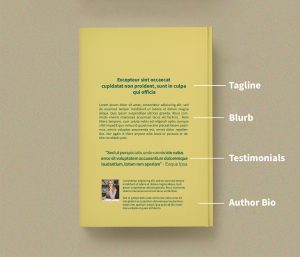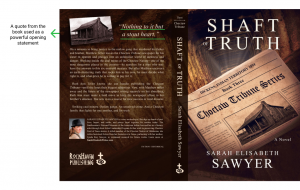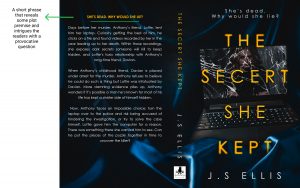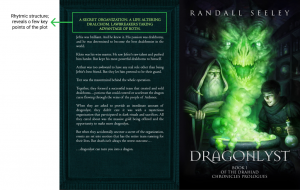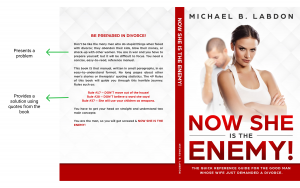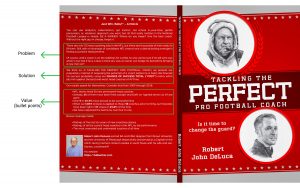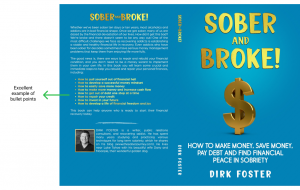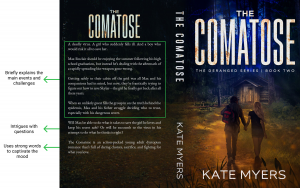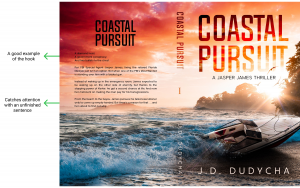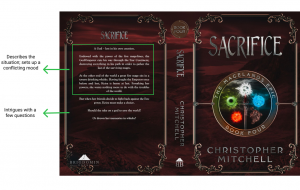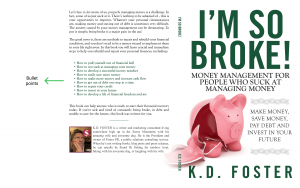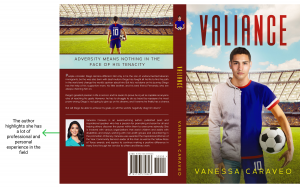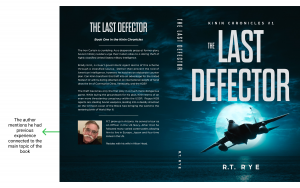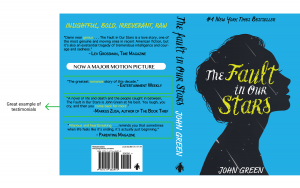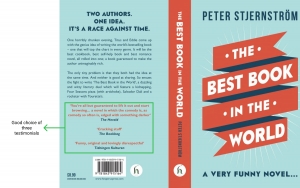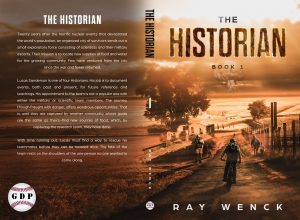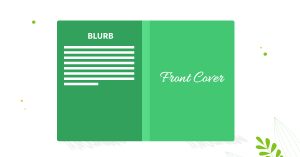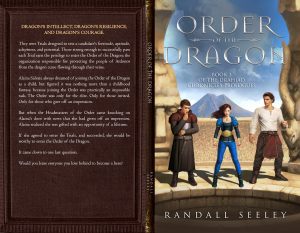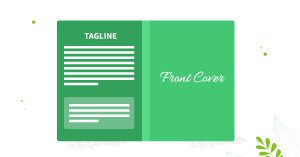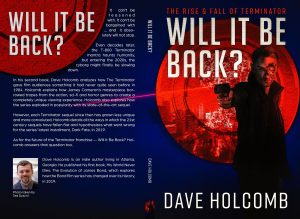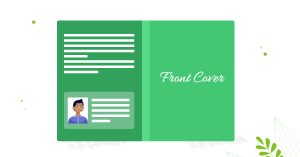There’s a widespread belief that a person spends only 8 seconds looking at the front book cover design.
Moreover, the same goes for the back cover: you have only a few seconds to grab a reader’s attention.
This means you need to beat the clock, so let’s get to it. In this blog post, you’ll learn how to compose a killer back book cover design so that a reader ends up being immediately hooked on it.
Why back book cover design matters
The back cover of a book is an important marketing tool. Think of it as of your sales pitch.
The information you include there is a primary ad for your book. It should provide a catching description of the book, squeezed in a couple of hundreds words to get the reader’s attention and keep them intrigued.
It’s also a place where you can say a couple of words about yourself. Make it simple, there’s no need to place a whole autobiography here, just a few phrases to summarize your professional work.
Last but not least, you can mention the endorsements and reviews of your book to add some value and credibility to the whole deal.
However, the back cover of a book is not a place where you should use fancy words or long content. Don’t forget, you should keep it short, clear and focused. Pretty tricky task and a huge responsibility for the book back cover design, isn’t it?
There’s also a popular misconception that in the online e-book world, there’s no need for a back book cover since nobody will ever see it.
Not really.
- Amazon now has the so-called “look inside” feature, which allows potential readers to take a sneak peek at the back cover.
- Kindle posts back covers for paperback editions, and this feature has been receiving a lot of positive reviews from customers.
- In order to upload your work to KDP Print, IngramSpark or BookBaby you have to include a front cover, spine, and back cover.
Now when you know about the importance of a back cover in your book cover design, let’s talk about the best practices of its layout.
We have a lot of amazing examples, so get yourself comfortable and keep reading.
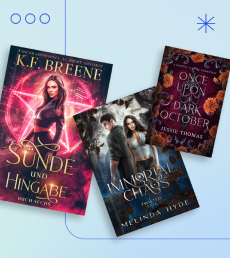
FREE RESOURCE
Everything an Indie Author Should Know About Book Cover Design
Enroll for a free email courseAnatomy of a back book cover
Take a look at the graph, which explains the back book cover layout.
As you can see the back book cover consists of the following elements:
- Tagline
- Blurb
- Author bio
- Testimonials
Now let’s take a closer look at these items.
Tagline
In general, the tagline feature gained wide popularity from film ads. Does this sound familiar?
When you can live forever what do you live for? (Spoiler alert, The Twilight Saga by Stephenie Meyer)
As you might have guessed, tagline is a short, catchy phrase that can be used as an advertising slogan.
Here are the main characteristics of a tagline:
- reveals the main plot premise or main idea;
- shows the uniqueness of your book;
- arouses interest or intrigues the reader (for example, asks a provocative question);
- should not sound too generalized or use cliches;
- sounds good, has a beautiful rhythmic structure;
- contains witty, funny and easy to remember phrase;
- uses a quote from your book that later on readers can easily recognize;
When coming up with a tagline, you’d better avoid using the title of the book, mentioning character names and composing a phrase longer than 10 words.
Tagline best practices
Check out some examples of a good tagline with useful tips and explanations.
Blurb
Blurb is a brief description of a book that should immediately attract the attention of your readers.
By the way, for e-books, it’s important to optimize the blurb for Amazon and other online retailers, since this book description will be posted on a purchasing page. Also,take into consideration that Amazon displays only the first few lines of the book description.
How can you come up with a catchy blurb that sells? First of all, aim at your target audience. A secret to a successful blurb is a proper research of the genre and readers’ expectations. That’s the reason why nonfiction and fiction books use different ingredients for their blurb cocktail.
For non-fiction books a well-done blurb should:
- present a problematic situation that needs to be solved;
- include an immediate solution to that problem (a good trick is to use bullet points here);
- explain what value the reader gets out of it;
For fiction books on the other hand, a blurb might:
- briefly describe the situation, give some hints without revealing the whole story
- start with a hook, one of the most existing plot points or twists
- set up the mood, describe the emotional state the readers might enter
- finish with an intrigue point (might be a rhetorical question or a tense unfinished sentence)
Take a look at these examples of fiction book cover design:
Both nonfiction and fiction books should:
- concentrate on a target audience;
- be short, aim for 100-200 words;
- avoid cliche phrases;
- be readable (clear paragraphs for fiction; bullet points for non-fiction);
- use present tense to create a feeling that the reader is getting involved in what is taking place at this very moment;
- avoid superlative tone (never should you ever use all capital letters);
The author bio is a great chance to to talk a bit about yourself and connect with the readers.
Keep in mind that most of the readers will see your biography before they read the book itself, so it can affect their ideas about the contents of your book. It is also recommended to go with the third person when writing the author bio, it sets a more neutral environment for the potential reader rather than a clear self-promotion guide.
The same target audience rule applies to the author bio as well. Pretty obvious, isn’t it?
Let’s say your book is a science fiction novel set in a galaxy far far away. In this scenario, your author bio should be different from when you’re writing about the best ways to improve your communication skills.
For non-fiction, it is extremely important to demonstrate the author’s competence in the subject. It is one thing if Mr. Nobody or Mrs. Newbie made the collection of recipes, and another thing if the author of the book is an award-winning professional chef.
Highlight what is worth mentioning and hide non-essential details that might affect credibility.
Oh, and of course…keep it short, approximately 75 words.
Author bio best practices
Here are some examples of an excellent author bio layout.
Testimonials
Testimonials are positive reviews on your book that come from well-known experts, publications, fellow authors or sometimes readers.
You should take care of testimonials even before your book is ready to be published. It takes some time to reach your target expert and get them to write a review on your piece of work. So be sure to plan everything.
Having a testimonial on your back book cover is extremely important to establish a so-called “social proof”, which means that the target audience trusts the opinion of someone who vouched for your book.
Bonus point: A review of the book written by an opinion leader can increase your book sales.
A great balance would be to gather two or three testimonials.
Testimonials best practices
We know that this falls into the category of setting the bar too high, but use it as an inspiration for the testimonials.
Let’s Review
As you might have noticed in all of the above examples, it’s perfectly fine to omit some parts when coming up with a back book cover. There are different variations of things you might want to include when writing your back cover copy.
It’s safe to say that unless you have 100 testimonials and are planning to use them, as your key selling point, you’ll definitely want to keep the blurb. Some self-publishing authors prefer to concentrate just on the blurb, and it looks great!
If you have a killer tagline that will make a particularly awesome hook, go for it! There are so many cases when the tagline entered a popular culture easily and became a business card of the book itself.
If your author bio is particularly relevant to this type of book and can serve as a selling point, we highly recommend building your back book cover design around it.
If you have a few good testimonials from well-known people in the industry, then nothing will go wrong if you put them all over the back book cover. Include only testimonials from highly recognized people in the field. If for any reason, you couldn’t reach them, it’s fine to omit this part altogether.
As you can see, there’s a lot of “ifs” when it comes to book back cover design and layout. Just think about it, look through your resources and decide on the excellent back cover for your book!
What do you include in your back book cover design? Share your ideas in the comment section below.


